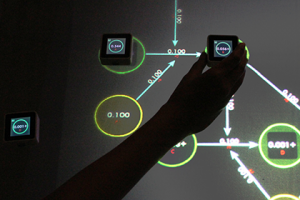|
"The project focuses on young people with a disability, particularly high school students, who are just starting to think about future careers. They will need accommodations and possibly need to start developing new skills in mastering assistive technologies to meet their career needs. Our project is to develop a tool to help users figure out potential accommodation needs that they might encounter in the future workplace and suggest possible solutions. "  |
Wearable systems play an important role in continuous health monitoring and can contribute to early detection of abnormal health-related events and facilitate the advancement of personalized healthcare. The neck is a unique sensing location because it provides access to a set of health-related data that other wearable devices simply cannot obtain. Activities including breathing, chewing, clearing the throat, coughing, swallowing, speech and even heartbeat can be recorded from around the neck. |
As time has gone by, research has pointed out that there remains skepticism in the community when it comes to using such tools that are focused around automating parts of the data discovery process. As my research as well as previous research has shown, practitioners prefer using traditional tools over newer tools, even if it involves more manual effort and time. The workflows that many data scientists follow today, do not completely utilize the new capabilities that are available to them through ML/AI. |
AccessCORPS is a vertically integrated project (VIP) team aiming to help make GT courses more accessible to students with disabilities. Website: |
|
The Accessible Bluetooth Cane project allows visually impaired users to control their iPhone while using the white cane, without having to stop and take out the phone. This is achieved by embedding Bluetooth remote controls with tactile buttons inside the cane handle.  |
Fantasy Sports allow users to compete against each other using statistics from real-world competitions. It's a fun and social online game which allows participants to assemble virtual teams of real world athletes of a professional sport. These teams compete based on the performance of their players in the real world. The team gains or loses points based on the real athletes' weekly performance. Fantasy players manage their teams based on real sports data. |
About 1 in 7 U.S. children will be affected with a developmental disability including Autism and Attention Deficit Hyperactivity Disorder (ADHD). Early diagnosis of developmental delays ensures proper intervention and overall improved qualities of life. In this research, we investigate how parents of young children use an Android mobile application, ActEarly, to log their children's developmental progress through milestones tracking techniques.  |
Active Pathways aims to support learning and discovery in systems biology by allowing users to construct and manipulate bio-chemical reaction network simulations using active tangibles on an interactive tabletop display surface. Researchers in systems biology currently run simulation programs that model different experimental parameters such as concentrations inside cells and reaction speeds. Parameters are adjusted algorithmically or by entering numbers into equations. The simulation results are then plotted as graphs in order to discover hidden patterns in the network.  |
|
Activity and Gesture Recognition for Mobile and Wearable Computing |
The goal of the research is to identify the ways in which social media could play a role in assisting Georgia Tech students to find mental health support. Mental health disorders are extremely prevalent on college campuses, and anxiety and depression, in particular, have been shown to have a negative effect on academic success. Despite the fact that mental health professionals and program are available to students with mental health conditions, many are not seeking help from their campus resources. |
Many electronic devices, from desktop computers to mobile phones to DVD players, can be thought of as a menu of functions. These functions can be accessible to a blind user if the menus are spoken aloud. However, this is extremely inefficient, so we have been enhancing auditory menus with sophisticated text-to-speech, spearcons, spindex, and other audio extensions. These can also be applied in many different languages and research is ongoing to look at more language applications, including tonal types.  |
Agility handlers need a reliable, accurate way to measure and monitor athlete activity to help reduce the high incidence of injury in agility dogs. Through this project, we hope to help develop a canine-wearable system to recognize agility activity in order to lay the groundwork for creating a user interface that can measure training workload, speed, fatigue, and other parameters to evaluate relation to injury risk and target injury prevention strategies. |
|
Our goal is to understand the needs of persons with mild cognitive impairment and their care partners when it comes to meal planning and food preparation with a focus on creating novel methods to capture information from the users regarding their household specific routines, preferences, values, and traditions that could be used to create AI interventions that are adapted to their individual needs.  Website: |
We are seeking to use AI to help high-school engineering teachers provide students with a more balanced approach across all steps of the engineering design process, and real-time, judgement-free feedback as they navigate open-ended challenges. Currently, the focus is on gaining a deeper understanding teachers' needs and pedagogical practices around the EDP which will inform our future design. |
Designing informal learning experiences to engage families in learning about artificial intelligence (AI). Website: |


